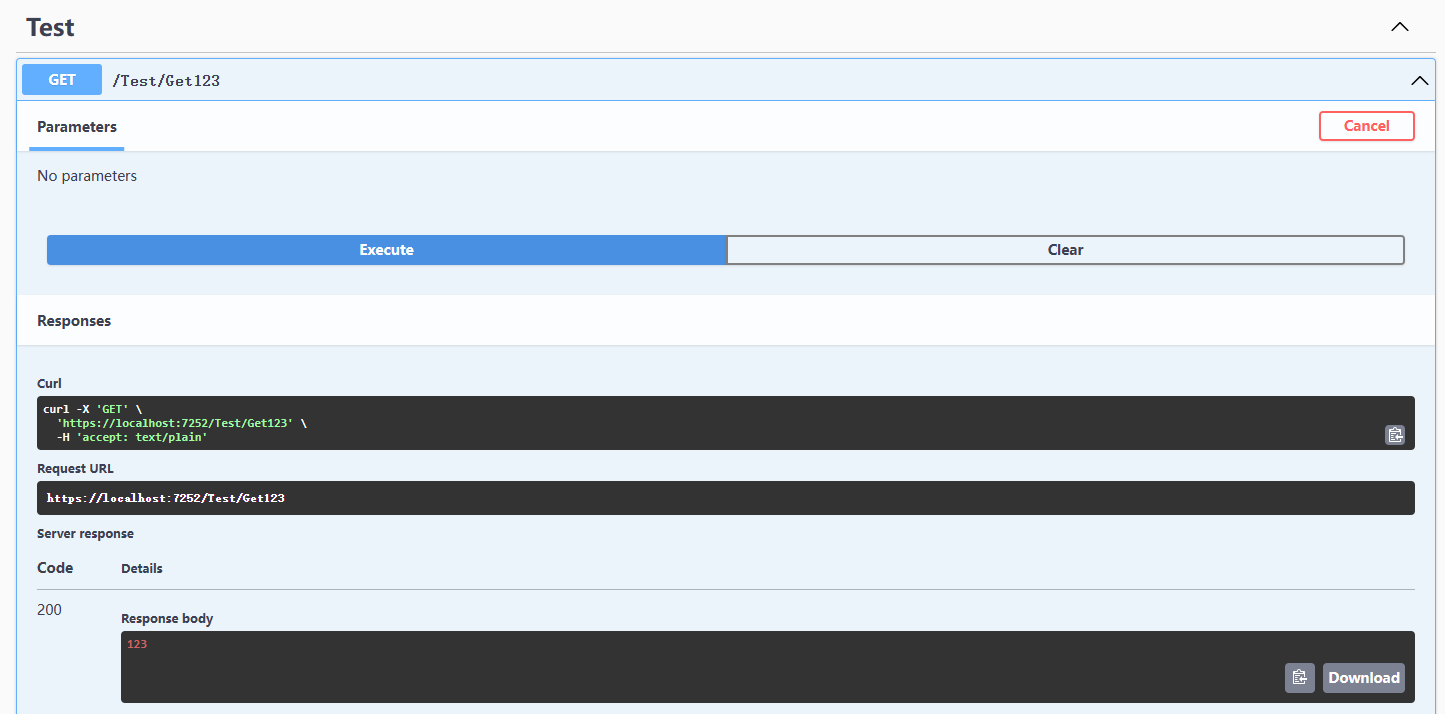如何在.net6webapi中使用自动依赖注入
IOC(Inversion of Control)控制反转:控制反正是一种设计思想,旨在将程序中的控制权从程序员转移到了容器中。容器负责管理对象之间的依赖关系,使得对象不再直接依赖于其他对象,而是通过依赖注入的方式来获取所需的资源。
DI(Dependency Injection)依赖注入:他是IOC的具体实现方式之一,使用最为广泛,DI通过在运行时动态地将某个依赖关系抽象为独立的组件,提交到容器之中,需要使用时再由容器注入,提升组件重用的频率,为系统搭建一个灵活,可扩展的平台。
IOC/DI是一种设计模式,用于解耦组件之间的依赖关系。在传统的编程模式中,组件之间的依赖关系是硬编码在代码中的,这样会导致代码的耦合度很高,难以维护和发展。而IOC/DI模式则是通过将组件之间的依赖关系交给容器来管理,组件不再直接依赖其他组件,而是通过容器来获取所依赖的对象。这样可以使组件之间的依赖关系更加灵活,容器可以根据需要动态地创建和管理组件,从而实现更好的可维护性和可扩展性。
如何在.net6webapi中使用依赖注入?首先我们定义一个服务接口及对应的实现
public interface ITestServices {int return123(); } public class TestServices : ITestServices {public int return123(){ return 123;} }然后我们在Program.cs注入服务实现
var builder = WebApplication.CreateBuilder(args);// Add services to the container.builder.Services.AddControllers();// Learn more about configuring Swagger/OpenAPI at https://aka.ms/aspnetcore/swashbucklebuilder.Services.AddEndpointsApiExplorer();builder.Services.AddSwaggerGen();builder.Services.AddTransient<ITestServices, TestServices>();var app = builder.Build();// Configure the HTTP request pipeline.if (app.Environment.IsDevelopment()){ app.UseSwagger(); app.UseSwaggerUI();}app.UseHttpsRedirection();app.UseAuthorization();app.MapControllers();app.Run();值得注意的是依赖注入有三种生命周期
作用域(Scoped):在应用程序启动时创建,并在应用程序关闭时销毁。这种类型的服务实例会被容器管理,但是只会被当前请求使用。当请求结束时,该服务实例会被销毁。单例(Singleton):在应用程序启动时创建,并在整个应用程序运行期间保持不变。这种类型的服务实例会被容器管理,并且可以被多个请求共享。瞬时(Transient):在应用程序启动时创建,并在应用程序关闭时销毁。这种类型的服务实例不会被容器管理,也不会被其他服务引用。最后在需要使用的控制器中构造函数注入就可以使用了
[Route('[controller]/[action]')] [ApiController] public class TestController : ControllerBase {private readonly ITestServices _testServices;public TestController(ITestServices testServices){ _testServices= testServices;}[HttpGet]public int Get123() => _testServices.return123(); }
依赖注入好归好,就是每个服务都得在Program.cs注入服务实现,一但服务多起来,麻烦不说,Program.cs中的代码更是会变得凌乱不堪,可能会有小伙伴说,可以开一个扩展函数单独做注入,但私以为,既然有一种方法可以一劳永逸,何乐而不为呢?
其实现便是利用.net的高级特性之一,反射
首先我们定义三个生命周期接口,其对应依赖注入的三种生命周期
//瞬时注入服务接口 public interface ITransient { } //作用域注入服务接口 public interface IScoped { } //单例注入服务接口 public interface ISingleton { }然后我们定义自动注入的扩展方法,其为核心实现
public static IServiceCollection RegisterAllServices(this IServiceCollection services){ //获取当前程序集 var entryAssembly = Assembly.GetEntryAssembly(); //获取所有类型 //!. null包容运算符,当你明确知道表达式的值不为null 使用!.(即null包容运算符)可以告知编译器这是预期行为,不应发出警告 //例: entryAssembly!.GetReferencedAssemblies() 正常 //entryAssembly.GetReferencedAssemblies() 编译器判断entryAssembly有可能为null,变量下方出现绿色波浪线警告 var types = entryAssembly!.GetReferencedAssemblies()//获取当前程序集所引用的外部程序集.Select(Assembly.Load)//装载.Concat(new List<Assembly>() { entryAssembly })//与本程序集合并.SelectMany(x => x.GetTypes())//获取所有类.Distinct();//排重 //三种生命周期分别注册 Register<ITransient>(types, services.AddTransient, services.AddTransient); Register<IScoped>(types, services.AddScoped, services.AddScoped); Register<ISingleton>(types, services.AddSingleton, services.AddSingleton); return services;}/// <summary>/// 根据服务标记的生命周期interface,不同生命周期注册到容器里面/// </summary>/// <typeparam name='TLifetime'>注册的生命周期</typeparam>/// <param name='types'>集合类型</param>/// <param name='register'>委托:成对注册</param>/// <param name='registerDirectly'>委托:直接注册服务实现</param>private static void Register<TLifetime>(IEnumerable<Type> types, Func<Type, Type, IServiceCollection> register, Func<Type, IServiceCollection> registerDirectly){ //找到所有标记了Tlifetime生命周期接口的实现类 var tImplements = types.Where(x => x.IsClass && !x.IsAbstract && x.GetInterfaces().Any(tinterface => tinterface == typeof(TLifetime))); //遍历,挨个以其他所有接口为key,当前实现为value注册到容器中 foreach (var t in tImplements) {//获取除生命周期接口外的所有其他接口var interfaces = t.GetInterfaces().Where(x => x != typeof(TLifetime));if (interfaces.Any()){ foreach (var i in interfaces) {register(i, t); }}//有时需要直接注入实现类本身registerDirectly(t); }}其核心逻辑便是通过反射扫描程序集,当扫描到实现了我们定义的生命周期接口时,为其实现对应的生命周期注入。
注册这个服务
builder.Services.RegisterAllServices();然后我们就可以通过继承生命周期接口来实现自动服务注入
public interface ITestServices {int return123(); } public class TestServices : ITestServices, ITransient {public int return123(){ return 123;} }接下来无需在Program.cs注入服务实现

调用成功。
到此这篇关于如何在.net6webapi中实现自动依赖注入的文章就介绍到这了,更多相关.net6webapi自动依赖注入内容请搜索好吧啦网以前的文章或继续浏览下面的相关文章希望大家以后多多支持好吧啦网!

 网公网安备
网公网安备